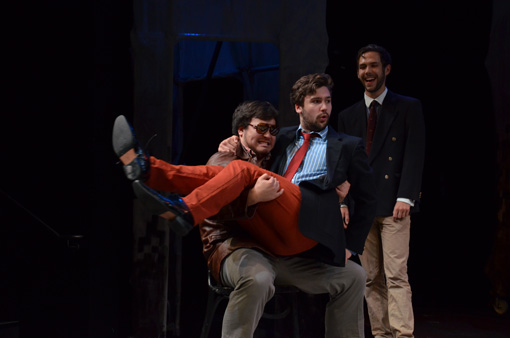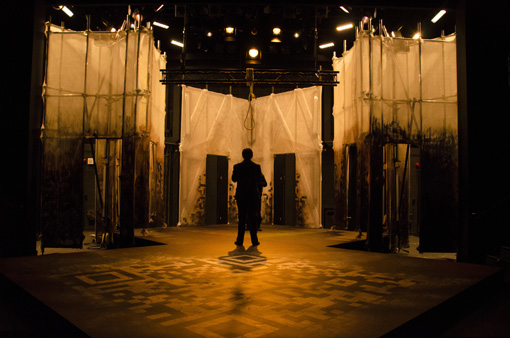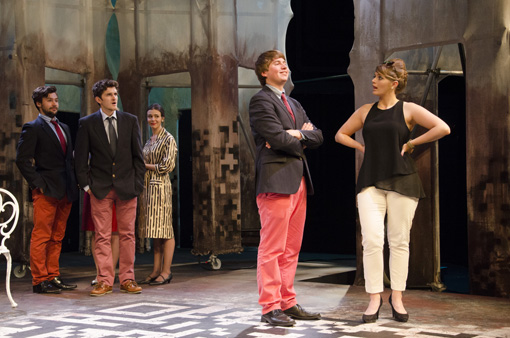The University of York has published a cross-disciplinary multimedia website detailing its staging of John Marston’s rarely-produced comedy The Dutch Courtesan. Michael Cordner looks at its realisation on the stage and online.
 About the author: Michael Cordner is Ken Dixon Professor of Drama and Head of Theatre in the Department of Theatre, Film and Television at the University of York. he is also the founder and general editor of Oxford English Drama for Oxford University Press.
About the author: Michael Cordner is Ken Dixon Professor of Drama and Head of Theatre in the Department of Theatre, Film and Television at the University of York. he is also the founder and general editor of Oxford English Drama for Oxford University Press.
In autumn 2010 the University of York’s newly created Department of Theatre, Film and Television moved into a specially designed, splendidly equipped, building, which contains an array of performance spaces, television and recording studios, and post-production labs. Possessing such remarkable resources challenges the department’s staff to invent fresh initiatives to match them.
My own research focuses on seventeenth-century drama, with a particular interest in the relationship between scripts and the performances that can be developed from them. I had previously taught in the University’s Department of English and Related Literature and had staged there a number of plays from this repertoire with student casts.
The best pre-civil war playscripts provide brilliantly crafted dialogue, which can be delivered in a rich variety of ways - and, therefore, to divergent effect – by its performers. Similarly, the scripts contain little or no indication of how they might be physically realised. However, eHHxploring in print alone how radically a scene by Marlowe or Webster can be transformed by subtle variations in vocal inflection or physical grouping poses severe problems, since we lack the calibrated technical vocabulary to convey such delicate calculations with precision. The internet’s capacity to combine video exemplification of performance choices with written analysis potentially provides us with a more effective means to examine such questions.
My next Jacobean production was scheduled for June 2013. What if this time we created a website which would, among other features, map aspects of the show’s planning and development and host a scholarly debate about the play? This time I was attracted by John Marston’s comedy The Dutch Courtesan, a play which has provoked lively scholarly interest, but about which little agreement has been reached. The situation is compounded by the scarcity of modern productions of The Dutch Courtesan. Stage history provides no substantive body of practical evidence against which academic theories and assertions about the play can be tested.

The Dutch Courtesan: Dan Cornwell (Mulligrub, R), Nick Armfield (Freevill, C), Stevie Jeram (Malheureux, L) (image: Dr Ollie Jones / University of York)
In 2011 I was responsible for the first staff-directed production – of Thomas Middleton’s A Mad World, My Masters – in my department’s largest theatre, a 208-seat thrust stage lay-out. Its opening performance was filmed, with the aid of a four-camera operation, under the direction of my colleague, Patrick Titley, a highly experienced television producer and director – a welcome early example of the cross-disciplinary collaborations the new department was created to foster. The success of that initial experiment meant I could confidently depend, for the website project, on a filming of the next production of professional quality; and beyond that the prospect of other collaborative possibilities with film, television and inter-active media colleagues beckoned.
Indispensable to the scheme was the appointment of a project administrator whose skills combined sophisticated knowledge about website design and development with research-level knowledge of early modern theatre. I was extremely fortunate to be able to secure for this post Dr Ollie Jones, who had just completed a PhD on touring theatre in the 1580s-1590s. Ollie has outstanding administrative abilities and also possesses the knowhow to design and construct the website – www.dutchcourtesan.co.uk – himself. He proved adept at fulfilling the key specifications set for it – in particular, that it should be easy to access and navigate, that it should be responsive to the needs of users with different kinds of interest in the subject it explored, and that it should encourage and facilitate cross-referencing between the different kinds of material it contained.

The Dutch Courtesan: Luke de Belder (Cocledemoy) (image: Dr Ollie Jones / University of York)
I was unsure how fellow scholars would respond to the invitation to contribute thought pieces about the play to a website which did not yet exist, but was delighted by the enthusiasm with which they greeted the idea. Six months after the website’s launch, we have, to date, posted fifteen explorations of subjects ranging from The Dutch Courtesan’s treatment of marriage, of religion, and of age and ageing, via an essay exploring the proposition that “If Shakespeare is the Beatles, Marston is the Kinks”, to a comparative study of Dutch and English city comedy c.1600. I have contributed three articles of my own, querying how the play has traditionally been discussed, and highlighting aspects of it which have, in my view, usually been misrepresented or disregarded. These articles grow from that exciting, unsettling, pre-rehearsal moment when familiar passages start to look strange and inexplicable, and when one lists puzzles and challenges which exploratory work with the actors must soon address.
The website also contains rehearsal footage and cast interviews. The show enjoyed the services of a professional designer, Jan Bee Brown, and had a specially composed musical score by Odinn Hilmarsson, while its lighting was designed by Roberto del Pino. All three explore their crucial contributions in separate filmed interviews. In addition, Perry Mills, celebrated for his productions of this repertory with casts composed entirely of boys from King Edward’s School, Stratford-upon-Avon, visited our rehearsals and worked with some of the actors. The Dutch Courtesan website contains a conversation between Perry and me after these sessions, comparing our experiences of working on the play in contrasting production circumstances. Finally, before the second performance of our production, I took part in a public debate (also filmed for the website), about Jacobean plays on the modern stage, with Michael Billington, the Guardian theatre-critic, who is also a Professional Associate of my department. Some of our discussion compares the different approaches to A Mad World, My Masters adopted by the 2013 Royal Shakespeare Company production of the play, for which I wrote a programme article and conducted a workshop with the cast, and my 2011 York one. Our website contains the film of our staging of the Middleton, as well as the film of The Dutch Courtesan.
We have therefore already put together a more variegated array of material than has been assembled by any similar site. But what we have so far provided is, we intend, only a beginning. In January 2014 I will be posting a detailed account, from the director’s point of view, of how the play changed for us during rehearsals, along with a director’s commentary (in conversation with my colleague Tom Cantrell) to accompany the film itself. I started rehearsals intensely sceptical about some dominant tendencies in the scholarship on the play – in particular, its frequent remoteness from the moment-by-moment volatility of Marston’s writing, and its inclination to substitute suspect moralisation for open-minded alertness to the complexity with which this provocative dramatist deploys his principal characters. One of my aims will be to direct attention to incidents largely ignored in the critical literature, but which challenged and absorbed us in rehearsal and, we hope, proved resonant in performance, and also to spotlight exchanges where the interpretative choices confronting actors are especially pregnant with alternative possibilities.

The Dutch Courtesan: Left to right, Nick Armfield (Freevill), Rory Hern (Tysefew), Emilie Smith (Putifer), Harry Whittaker (Caqueteur), Eliza Shea (Crispinella). (image: Dr Ollie Jones / University of York)
This fresh analysis, in dialogue with the video evidence, will be offered as an invitation to others to write up, for posting on the website, their own views of the play in the light of our experiment, and of the decisions about how to stage the play which our rehearsals generated. The play’s final movement, for example, brings its two main plots together in a bravura scene in the shadow of the gallows, in which two men, innocent of the crimes for which they are condemned, face execution. At the start of rehearsals, I would have been unable to predict the decisions we finally made about how to play the endings of these stories. By narrating the process by which we made these unexpected choices, we hope to stimulate a continuing online debate about this extraordinary play.
But our plans reach further. We aim to develop a twin website to the existing one, on which we will explore – via filmed rehearsal experiments and accompanying analysis and discussion – the distinctive technical and interpretative demands different leading Jacobean playwrights make upon their players, even when they are exploring similar material. This seems to us a subject of fundamental importance, which has, however, received scarcely any serious scholarly attention. The fusion of materials which the internet can accommodate, however, offers us a new way to approach this question and prompt debate about it. Our first step will be to compare plays by Ben Jonson and Thomas Middleton from this perspective. We plan to launch our explorations via a rehearsal experiment in which the actress Penelope Wilton – a brilliant Livia in the 2006 Royal Shakespeare Company production of Middleton’s Women Beware Women – will be filmed working with student actors on a Livia/Isabella scene from the play. Watch this space.
Professor Michael Cordner